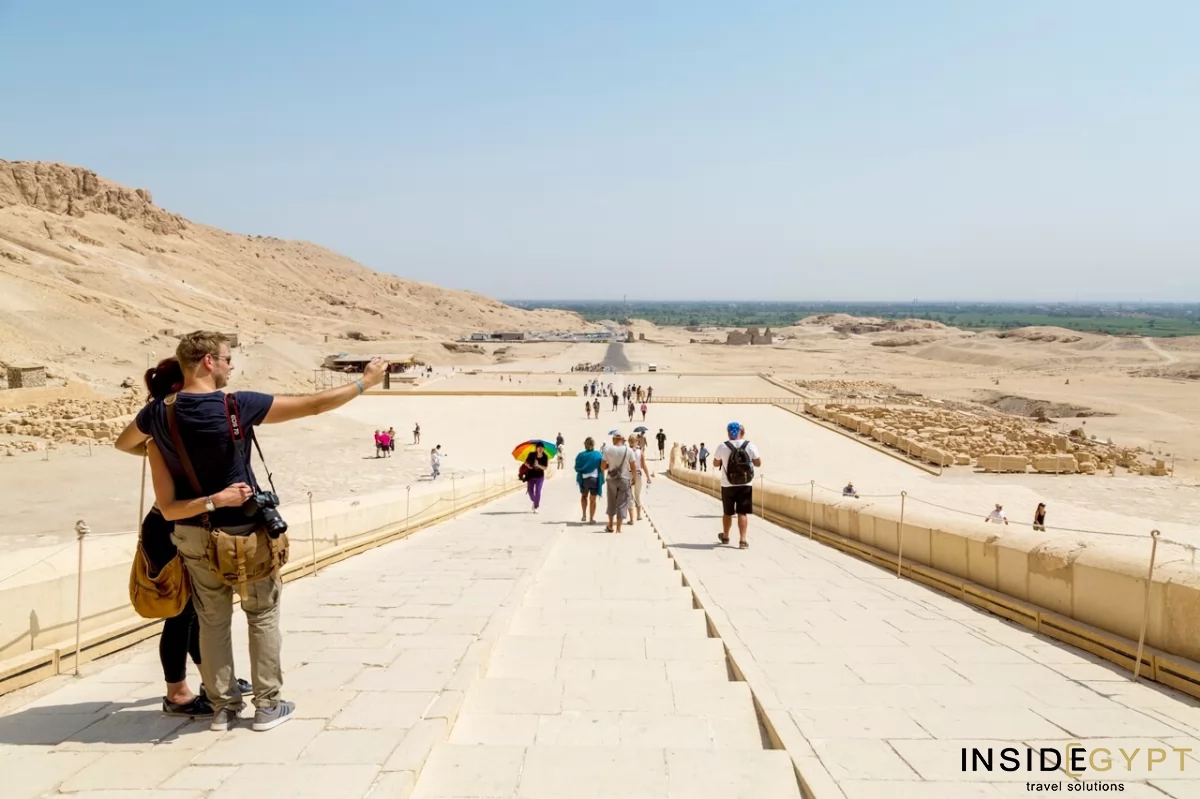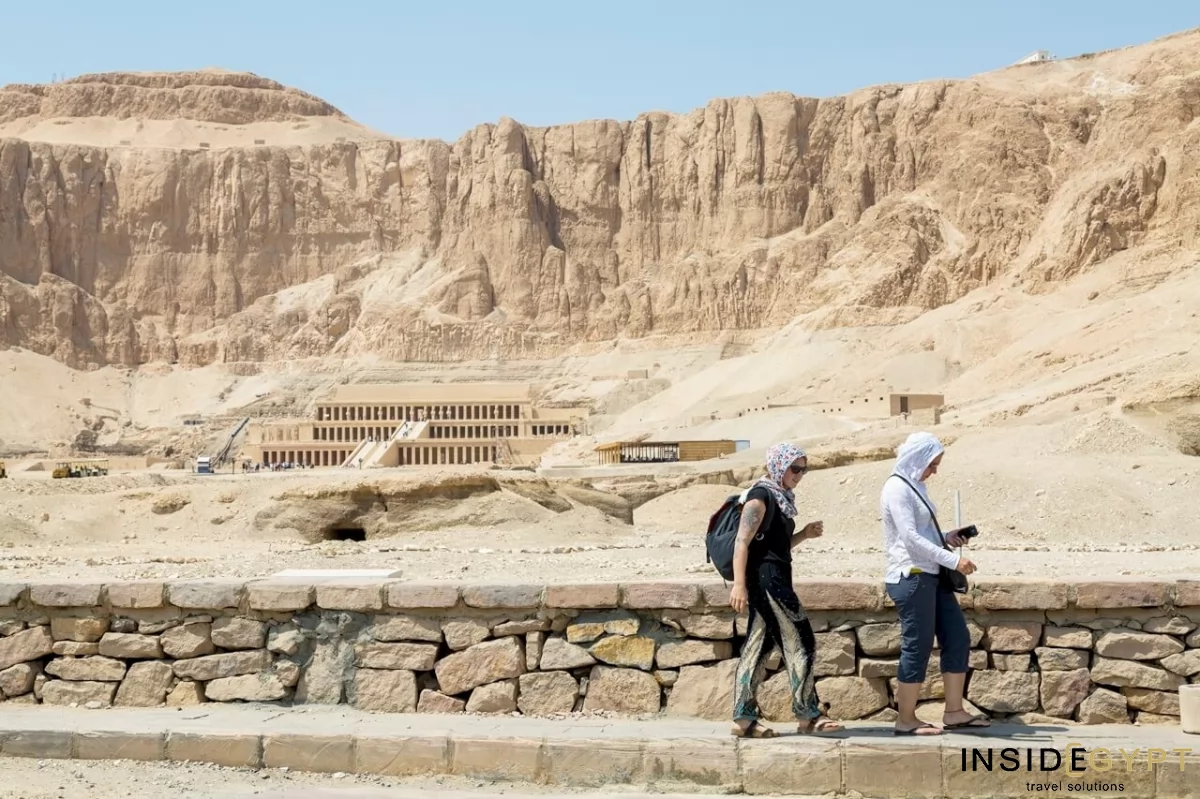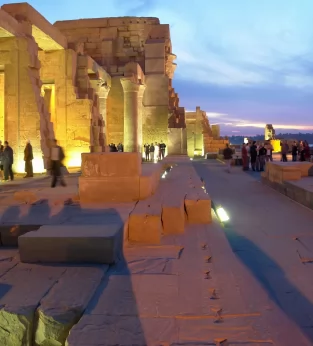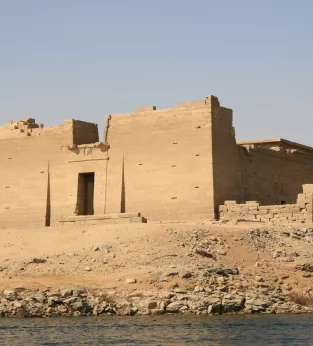Stay updated!
Immerse yourself in the grandeur and mystique of the Temple of Hatshepsut during an unforgettable Nile Cruise experience that promises unparalleled comfort, convenience, and expert guidance. Step onboard Inside Egypt's premium tour package and embark on a once-in-a-lifetime journey to Queen Hatshepsut's renowned temple when the ship docks in Luxor, combining exceptional amenities with top-tier services to ensure a truly memorable and enriching exploration of this ancient Egyptian marvel.
This awe-inspiring temple visit is just one of the many mesmerizing experiences offered in our comprehensive 17 Days in Egypt on a Long Nile Cruise, 14 Days in Egypt Tour, and 10-Day Trip to Egypt as well as 8 Days Egypt Tour.
Embark on a deluxe adventure as you travel in style from your luxurious and contemporary ship to the Temple of Hatshepsut and back, all while marveling at the picturesque views along the majestic Nile River. At the temple, let a seasoned Egyptologist, fluent in English and well-versed in the rich history and significance of Hatshepsut's funerary temple, guide you through its storied halls and remarkable architecture. Queen Hatshepsut tomb
But the luxury experience doesn't stop there. Your tour will be further elevated by the presence of a dedicated tour leader, a travel concierge who anticipates and addresses your every need, ensuring a seamless and stress-free journey from beginning to end. From managing logistics to providing personalized support, your tour leader is committed to making your visit to the Temple of Hatshepsut truly exceptional.
Uncover the splendor of Queen Hatshepsut's temple in unparalleled comfort and style with Inside Egypt's luxurious Nile Cruise tour, designed to elevate your exploration of ancient Egypt to new heights of sophistication and satisfaction.
Join us as we delve into this architectural masterpiece during our Egypt tours. Reserve your spot on a luxury Egypt tour today for an unforgettable experience.
Photos of Queen Hatshepsut’s Temple in Egypt
















Discover Our Exclusive Egypt Tours
Tour Reviews
Hatshepsut Temple FAQs
Why is the Mortuary Temple of Hatshepsut Important?
.webp)
The Mortuary Temple of Hatshepsut is a remarkable ancient Egyptian structure located on the west bank of the Nile near Luxor. Built during the reign of Queen Hatshepsut, one of ancient Egypt's most powerful female pharaohs, this temple serves as a testament to her legacy and achievements.
The temple stands out for its unique architectural design, featuring terraces, colonnades, and statues that blend harmoniously with the surrounding natural landscape. The temple's construction was overseen by Senenmut, Hatshepsut's trusted advisor and architect, and it served as both a mortuary temple for the queen and a place of worship for the gods.
As Hatshepsut's funerary temple, this site played a crucial role in the pharaoh's posthumous commemoration and the continuation of her cult following her death. The temple's historical significance lies in its association with Hatshepsut's unprecedented rise to power as a female ruler in a predominantly male-dominated society.
Today, the Temple of Hatshepsut stands as a symbol of architectural mastery and political prowess, highlighting Queen Hatshepsut's enduring impact on ancient Egyptian history. Its impressive grandeur and artistic details make it a must-visit destination for those interested in ancient Egypt's rich heritage and the remarkable reign of Queen Hatshepsut.
When was the Temple of Hatshepsut Built?
.webp)
The Temple of Hatshepsut, also known as Djeser-Djeseru, was constructed during the 15th century BC in the ancient city of Thebes, present-day Luxor, Egypt. This magnificent mortuary temple was commissioned by Queen Hatshepsut and designed by her architect Senenmut to serve as a commemorative structure for the queen's reign and as a place of worship for the gods.
Located in the Deir el-Bahari complex on the west bank of the Nile, the Temple of Hatshepsut is a masterpiece of ancient Egyptian architecture, characterized by its terraced structure, colonnaded halls, and stunning reliefs depicting scenes of the queen's divine birth and achievements. The temple's design reflects a harmonious blend of natural surroundings and man-made structure, showcasing the artistic and engineering prowess of the time.
Throughout its history, the Temple of Hatshepsut has undergone periods of restoration and conservation efforts to preserve its grandeur and historical significance. As a focal point of Hatshepsut's religion and cult following, the temple played a crucial role in the queen's posthumous legacy and the propagation of her divine status in ancient Egyptian religion.
Today, the Temple of Hatshepsut stands as a testament to the queen's extraordinary reign and enduring impact on ancient Egyptian history and religion, attracting visitors from around the world to marvel at its architectural splendor and historical importance.
How was the Temple of Hatshepsut Built?

The construction of the Temple of Hatshepsut was a remarkable feat of ancient Egyptian engineering and craftsmanship. The mortuary temple dedicated to Queen Hatshepsut was built using meticulous planning, skilled labor, and advanced techniques of the time.
It was constructed with limestone quarried from the cliffs of al Deir el-Bahari, providing a durable and aesthetically pleasing material for the building's foundation and structure. The architects and builders employed traditional tools such as copper chisels, wooden mallets, and ropes, along with more advanced tools like bronze saws and drills for precision carving and shaping of the stone blocks.
The construction of the temple required a substantial workforce, including skilled craftsmen, laborers, and overseers, who worked under the direction of Hatshepsut's chief architect Senenmut. The exact number of people involved in the construction is not definitively known but would have likely been in the hundreds, given the scale and complexity of the project.
The construction of Hatshepsut's funerary temple spanned several years, with estimates suggesting it took around 15 years to complete, from the early stages of quarrying and carving the stone blocks to the final touches of decorating the temple with intricate reliefs and statues. The labor and expertise invested in building the Temple of Hatshepsut underscored the ancient Egyptians' architectural achievements and reverence for their queens and pharaohs.
What is the Temple of Hatshepsut Made Of?

The Temple of Hatshepsut, or Djeser-Djeseru, was primarily constructed using limestone quarried from the cliffs, where the temple is situated. Limestone was a popular building material in ancient Egypt due to its abundance, ease of quarrying, and durability. The white limestone blocks used in the construction of the temple provided a stark contrast to the surrounding reddish sandstone cliffs, enhancing the visual impact of the structure.
The walls and pillars of Hatshepsut's mortuary temple were adorned with colorful paintings, created using natural pigments derived from minerals like ochre, malachite, and charcoal. These vibrant pigments were mixed with various binders such as egg whites or gum to create durable paints that have withstood the test of time, offering glimpses into the artistry and beliefs of ancient Egyptian culture.
Inside the temple, intricate mosaics depicting scenes from Queen Hatshepsut's divine birth and reign adorned the walls, adding to the temple's grandeur and religious significance. These mosaics were meticulously crafted using small colored stone chips called tesserae, carefully arranged to create detailed images that reflected the queen's divine status and connection to the gods.
The use of limestone, colorful paintings, and elaborate mosaics in the construction and decoration of Hatshepsut's temple not only showcased the advanced craftsmanship of ancient Egyptian artisans but also served to glorify the queen's legacy and religious significance within the context of ancient Egyptian religion and architecture.
Is Hatshepsut’s Temple Part of the Valley of the Kings in Luxor, Egypt?

Hatshepsut's Temple is not located within the Valley of the Kings in Luxor, Egypt. But, British archaeologist Howard Carter discover Queen Hatshepsut's tomb in the Valley of the Kings in 1902 while excavating there. An archaeologist found two sarcophagi in Hatshepsut's tomb. One belonged to Hashepsut's father and the other to herself. But both sarcophagi were empty. The temple is situated on the west bank of the Nile River, adjacent to the Valley of the Queens. This location was a deliberate choice due to its proximity to the ancient city of Thebes and its significance as a religious and funerary center in ancient Egypt.
The selection of Deir el-Bahari for Queen Hatshepsut's mortuary temple was a strategic decision that reflected the queen's desire to honor her reign and legacy in a prominent and visually striking location. The natural amphitheater-like setting of the cliffs provided an ideal backdrop for the temple's terraced structure, allowing it to stand out amidst the rugged landscape.
While not part of the Valley of the Kings, the Temple of Hatshepsut's location near other royal mortuary temples and tombs reinforced its role as a prestigious funerary monument dedicated to the queen's memory and divine status. The proximity to the Valley of the Queens further emphasized the importance of the site as a place of reverence and commemoration for elite individuals, particularly queens and royal consorts, in ancient Egyptian society.
Overall, the location was a deliberate choice that underscored the queen's status and significance in ancient Egyptian history and religion, ensuring her enduring legacy within the cultural landscape of Luxor.
What Else is There to Do in Al Deir al Bahari?
.webp)
In addition to the famed Temple of Hatshepsut, there are several other remarkable attractions worth exploring in the area. One such site is the Mortuary Temple of Mentuhotep II, located nearby, which predates the Hatshepsut's tomb and offers insights into the evolution of ancient Egyptian temple architecture and religious practices.
Visitors can also explore the Tombs of the Nobles, a collection of rock-cut tombs belonging to high-ranking officials and dignitaries from the New Kingdom period. These tombs feature intricate decorations, colorful paintings, and hieroglyphic inscriptions that provide a glimpse into the elite society of ancient Egypt.
For those interested in ancient Egyptian art and history, the Open-Air Museum offers a fascinating display of statues, stelae, and architectural fragments recovered from the surrounding temples and tombs. This museum provides a unique opportunity to appreciate the artistic achievements of the ancient Egyptians up close.
When visiting Deir el-Bahari and its surrounding attractions, it is essential to dress modestly and respectfully to adhere to local customs and cultural traditions. Wearing clothing that covers shoulders, chest, and knees is recommended out of respect for the religious significance of the sites and to ensure a smooth and respectful visit.
Exploring here presents a rich tapestry of ancient Egyptian history, art, and culture, making it a captivating destination for travelers seeking to delve into the wonders of Luxor's archaeological heritage.
What Other Visitors to Queen Hatshepsut’s Temple Have Said

The Temple of Hatshepsut, located in Egypt, is a fascinating site that offers several attractions sure to delight tourists. This impressive structure is a prime example of ancient Egyptian architecture.Visitors can admire the grand colonnaded halls of the temple, which are adorned with intricate reliefs and hieroglyphics depicting scenes from Egyptian mythology and history. The temple complex includes various chapels and sanctuaries dedicated to different gods and pharaohs, providing a glimpse into ancient Egyptian religious practices.The terraces and ramps of the temple offer panoramic views of the surrounding landscape, making it a great spot for photography and taking in the beauty of the area.
Client testimonials highlight the temple's allure and significance:
"Nestled within the scenic landscape, the Hatshepsut mortuary temple emerges as a vision of beauty and serenity. Its picturesque setting enchants, offering a stunning blend of architectural grandeur and natural splendor. The exterior, a true marvel to behold, boasts intricate details and a majestic presence that leaves a lasting impression. As the sunlight dances upon its walls and columns, the temple exudes a sense of timeless magnificence. It's a pity, however, that I didn't see Hatshepsut's tomb."
Anne
"From afar, an awe-inspiring sight awaited us after our exploration of the Valley of the Kings. Set against the dramatic backdrop of desert cliffs, this remarkable edifice was constructed under the rule of the renowned female Pharaoh, Hatshepsut. The intricate architecture, extensive passageways, towering statues, and carefully crafted pillars all contribute to this ancient marvel. Gracing the landscape are three tiers, each offering a unique perspective with a grand portico and ascending temple path, showcasing the opulent legacy of Egypt's past." Jim & Katherine
Experience the magic of the Mortuary Temple of Hatshepsut and the Valley of the Kings, where history, artistry, and spirituality converge in a mesmerizing journey through ancient Egypt's past.
Other Sites Nearby

In the vicinity of temple in Deir el-Bahari, there are numerous other captivating sites waiting to be explored, enriching the Egyptian itinerary for history enthusiasts and travelers alike.
The Colossi of Memnon, two massive stone statues of Pharaoh Amenhotep III, stand proudly in the Theban necropolis and serve as iconic symbols of ancient Egypt's grandeur and architectural prowess. The statues offer a glimpse into the monumental statues that once lined the entrance to Amenhotep III's mortuary temple.
A short distance away lies the renowned Valley of the Kings, a UNESCO World Heritage site that houses the tombs of many pharaohs and nobles from the New Kingdom period. This archaeological treasure trove offers a fascinating glimpse into ancient Egyptian funerary practices and beliefs, with well-preserved tombs such as that of Tutankhamun captivating visitors with their intricate decorations and hidden chambers.
For a deeper dive into daily life in ancient Egypt, Deir el-Medina, the workers' village of the Valley of the Kings, provides insights into the lives of the artisans and laborers who built the royal tombs. The well-preserved mud-brick structures and detailed paintings offer a unique perspective on the challenges and triumphs of these skilled craftsmen.
The Valley of the Queens offers a more intimate view of royal burials, with tombs dedicated to queens and royal children. Meanwhile, Medinet Habu, the mortuary temple of Ramesses III, showcases stunning reliefs and architecture that highlight the power and grandeur of Egypt's New Kingdom rulers.
Exploring these additional sites in the Luxor region promises a comprehensive journey through ancient Egyptian history and culture, providing a rich tapestry of experiences for travelers eager to delve into the wonders of the past.










